
The Toshiba EMI Recordings / Original Stereo Version
13. A Collection Of Beatles Oldies (OP/AP-8016)
(Update: 16th July 2025)

| TITLE | A BEATLES
COLLECTION OF OLDIES |
||||
| CATALOG NUMBER | OP-8016 |
||||
| RELEASE DATE | Promotional
Record
(First Press: 5th February.1967) |
||||
| TRACK LISTING | SIDE 1 | SIDE 2 | |||
| She Loves You (simulated stereo) |
Can't Buy Me Love |
||||
| From Me To You |
Bad Boy |
||||
| We Can Work It Out |
Day Tripper |
||||
| Help! |
A Hard Day's Night |
||||
| Michelle |
Ticket To Ride |
||||
| Yesterday |
Paperback Writer |
||||
| I Feel Fine | Eleanor Rioby |
||||
| Yellow Submarine |
I Want To Hold Your Hand |
||||
| FRONT --> Click! | BACK --> Click! | SIDE 1 --> Click! | SIDE 2 --> Click! | DISK | |
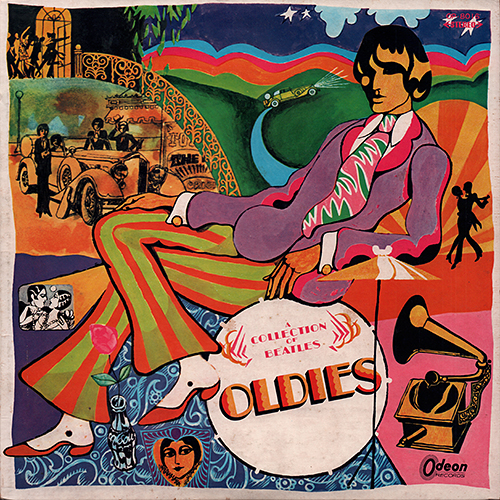 |
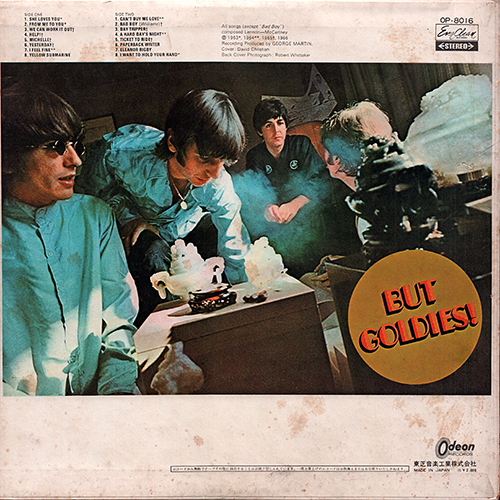 |
 |
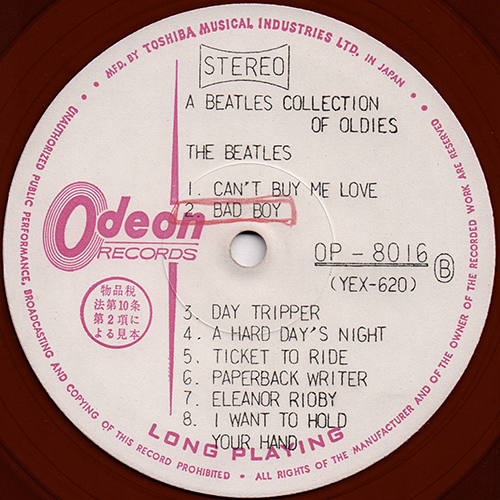 |
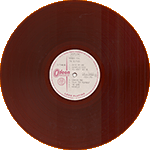 |
|
| INNER SLEEVE |
LYRIC
SHEET (Bifold Type)
|
||||
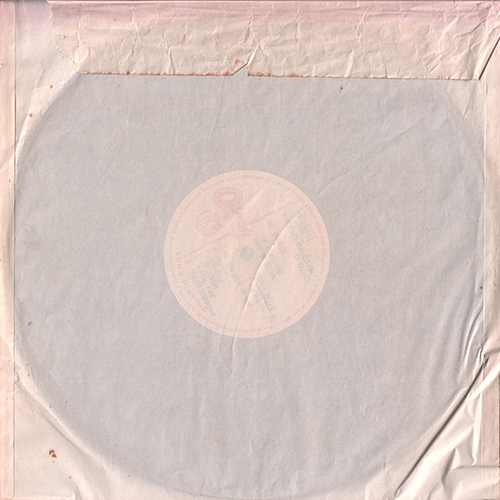 |
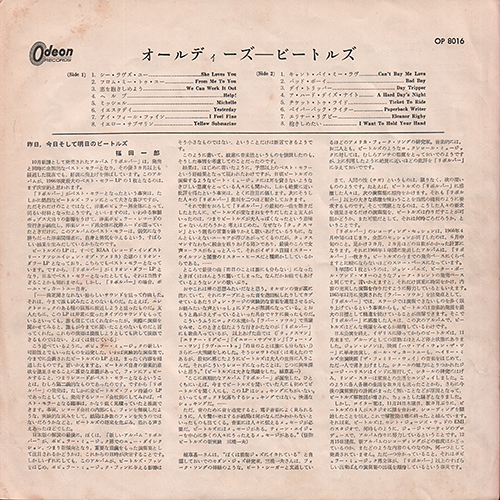 |
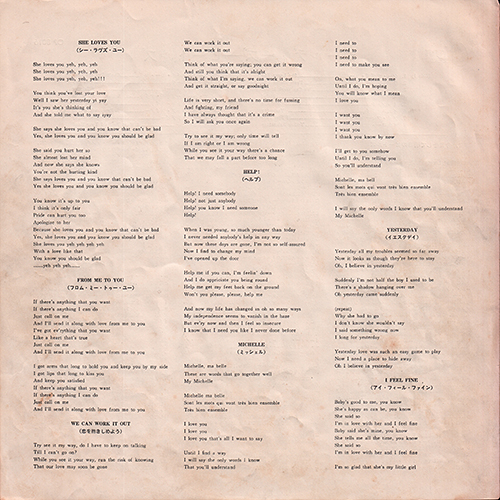 |
 |
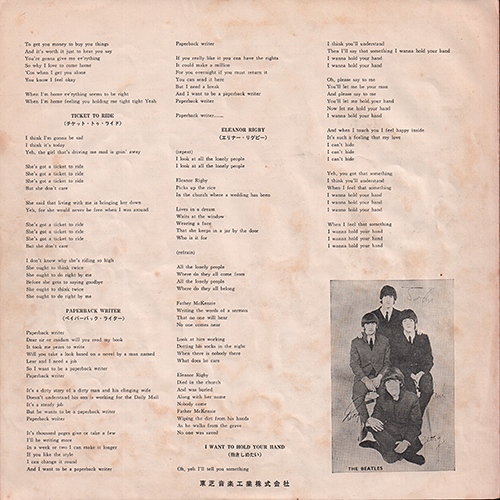 |
|
| LYRIC SHEET CLOSE
UP |
|||||
 |
 |
 |
|||
| Catalog number "OP 8016" was printed. |
Liner notes: Ichiro Fukuda. |
"Toshiba Musical Industries Ltd." was printed on the lyric sheet. | |||
| FRONT COVER CLOSE UP | |||||
| Japanese Press |
U.K. Press | U.K.
Pressings:
The photo on the back cover is backwards. It was taken in
Tokyo, Japan in 1966; the clue is on Paul's kimono-the
lettering "KOTOBUKI" is backwards. Japanese issue of the LP
have corrected the photo. |
|||
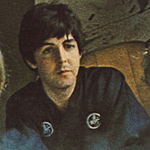 |
 |
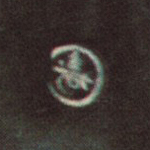 |
|||
| FRONT COVER CLOSE UP | BACK COVER CLOSE UP | ||||
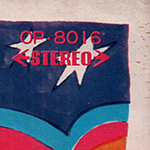 |
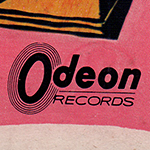 |
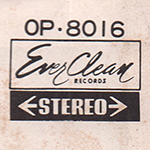 |
Odeon
logo
mark and catalog number "OR 8016" were printed on both sides
of the cover. "EverClean" record logo mark was printed at the upper right corner of the back cover. |
||
| BACK COVER CLOSE UP | |||||
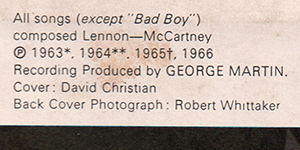 |
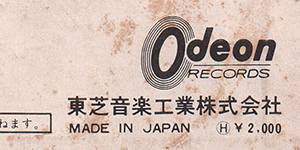 |
"Toshiba Musical
Industries Ltd." and "H-¥2,000" were printed at the bottom
of the back cover. |
|||
| LABEL CLOSE UP | |||||
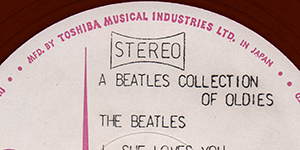 |
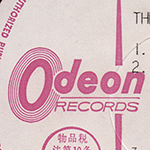 |
Odeon white
label (promotional use only). The words "MFD. BY TOSHIBA MUSICAL INDUSTRIES LTD. IN JAPAN" was printed at the perimeter. The release date was not printed on both labels. |
|||
| LABEL CLOSE UP | |||||
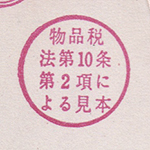 |
Here is a close-up of the circled text: "Sample under Article 10, Clause 2 of the Commodity Tax Law". | 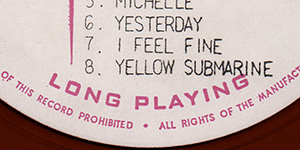 |
The words "LONG PLAYING" was printed at the bottom of the label. | ||
| LABEL CLOSE UP | |||||
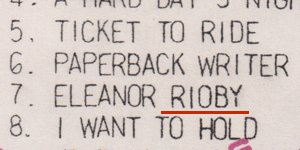 |
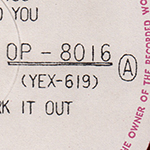 |
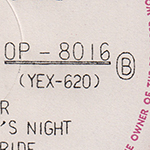 |
The print in black has unusual "hand lettered" look to it quite unlike the regular commercial version. Catalog number and matrix number were printed at the right side of the center hole. | ||
|
OTHER ITEM
|
|||||
| - | |||||
| RECORD LABEL | Odeon White Label (for promotional use
only) |
||||
| MIX | STEREO |
||||
| MATRIX No. | SIDE 1 | YEX-619 1S 1 |
|||
| SIDE 2 | YEX-620
1S 1 |
||||
| PRESS MARK | None |
||||
| VINYL COLOR | RED |
||||
| RECORD COMPANY'S NAME | SLEEVE | Toshiba
Ongaku kogyo Kabusikigaisha |
|||
| LABEL | MFD. BY
TOSHIBA MUSICAL INDUSTRIES LTD. IN JAPAN |
||||
| SYMBOL/PRICE | H - ¥2,000 |
||||
| LYRIC SHEET STYLE | Bifold Type |
||||
| COVER FORM | Single type. Hard cover. |
||||
| INNER SLEEVE |
Plain
White Inner bag |
||||
| OBI |
- |
||||
| COVER DESIGN/ PHOTO/ NOTES | Cover: David Christian Back Cover Photo: Robert Whittaker Liner Notes: Ichio Fukuda |
||||
|
COMMENTS
|
Odeon white label
(promotional use only). The words "MFD. BY TOSHIBA MUSICAL INDUSTRIES LTD. IN JAPAN" was printed at the perimeter. Odeon promo LPs feature the perimeter print, Odeon logo, and circled text in red and all other printing in "hand lettered" black. Note the release date above the Odeon logo. The label design is similar to that used for the regular commercial Odeon LPs. These are most commonly found on red vinyl. In Japan, promotional records have traditionally been provided at no charge to radio stations, record shops, and the mass media to increase the sales of a record or in some cases to promote a tour. There are two types of promotional releases. Type-1: This type is called the white label promo for which a unique label has been made. The label design of Odeon white label singles is very similar to that of regular commercial Odeon singles. The promo version, however, features the perimeter print, Odeon logo, and circled text in red and all other printing in black. The print in black has an unusual "hand lettered" look to it quite unlike the regular commercial version. The release date is in black and appears above and to the left of the title. Most usually, the regular cover is used with appropriate alterations to prohibit commercial sale. Type-2: The second type of promo record is less elaborate and is called a sticker promo. It is simply a regular commercial release that has a promo sticker affixed to the cover. This type of promo is occasionally found on post-1975 releases. The front cover is similar to its U.K. counterpart, but the back cover photo is reversed (Japanese edition is correct). These copies mistitled the album title "A collection..." as "A Beatles collection..." on the spine of the cover and the label. This stereo versions of "She Loves You" have been created from the mono versions, because original master tapes are lost. |
||||
| TITLE | A BEATLES
COLLECTION OF OLDIES |
||||
| CATALOG NUMBER | OP-8016 |
||||
| RELEASE DATE | 5th February.1967 / First Press |
||||
| TRACK LISTING | SIDE 1 | SIDE 2 | |||
| She Loves You (simulated stereo) |
Can't Buy Me Love |
||||
| From Me To You |
Bad Boy |
||||
| We Can Work It Out |
Day Tripper |
||||
| Help! |
A Hard Day's Night |
||||
| Michelle |
Ticket To Ride |
||||
| Yesterday |
Paperback Writer |
||||
| I Feel Fine |
Eleanor Rigby |
||||
| Yellow Submarine |
I Want To Hold Your Hand |
||||
| FRONT --> Click! | BACK --> Click! | SIDE 1 --> Click! | SIDE 2 --> Click! | DISK | |
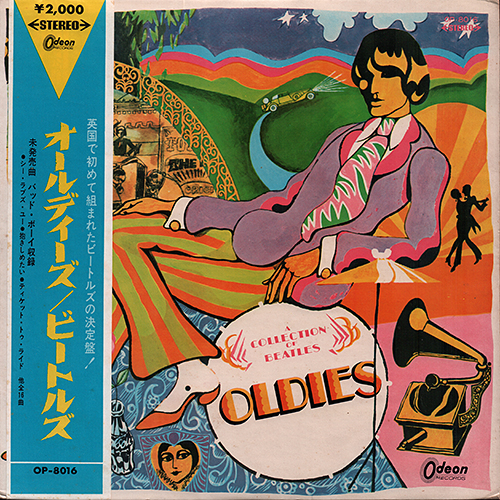 |
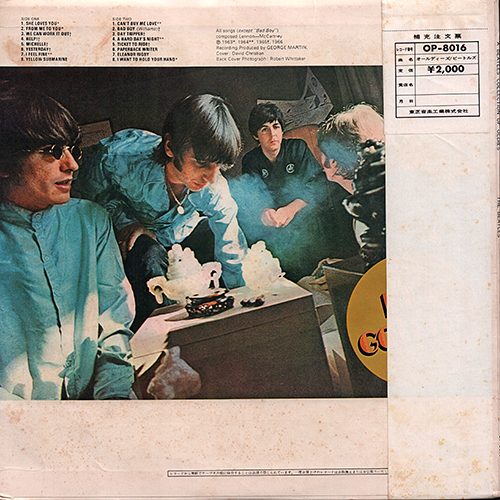 |
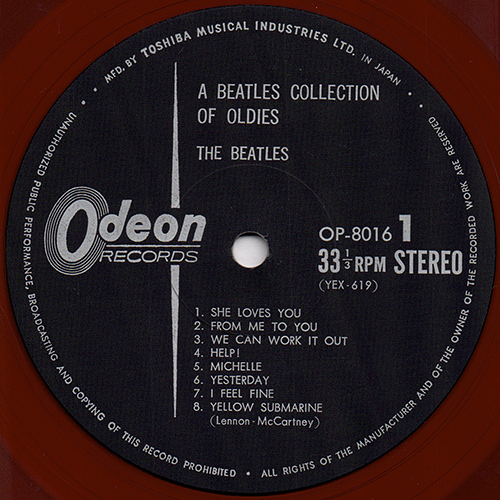 |
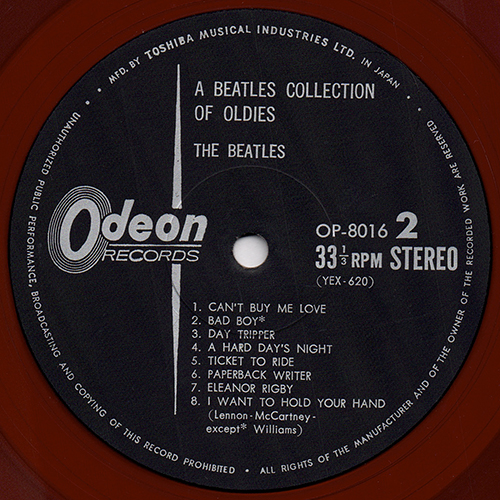 |
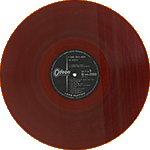 |
|
| INNER SLEEVE |
INNER SLEEVE CLOSE UP |
||||
| FRONT --> Click! | BACK --> Click! | ||||
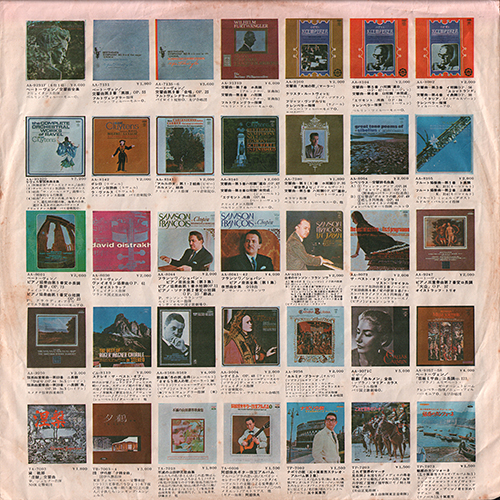 |
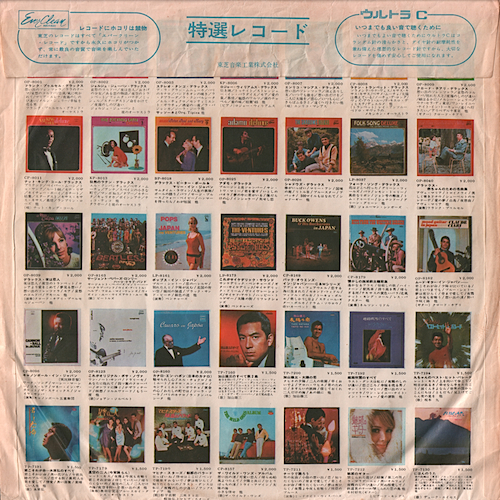 |
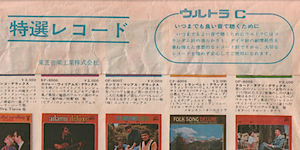 |
The original colour "advert" inner bag has a fold-over flap at the top of the bag to prevent the record from falling out. | ||
|
LYRIC
SHEET (Bifold Type)
|
|||||
 |
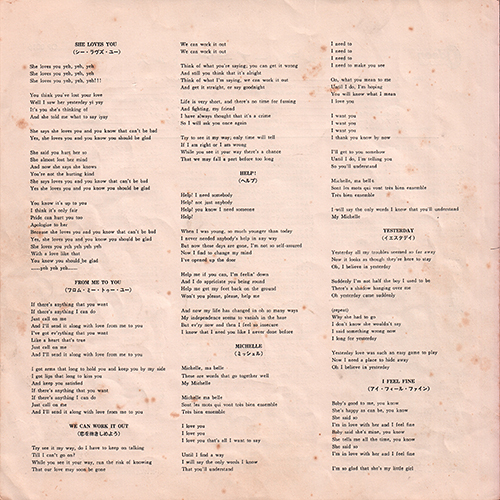 |
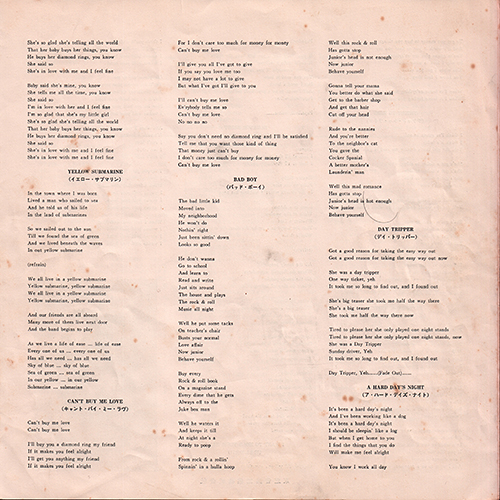 |
 |
The lyric sheet is bifold type. | |
| LYRIC SHEET CLOSE
UP |
|||||
 |
 |
 |
|||
| Catalog number "OP 8016" was printed. |
Liner notes: Ichiro Fukuda. |
"Toshiba Musical Industries Ltd." was printed on the lyric sheet. | |||
| Light Blue / Yellow OBI CLOSE UP | |||||
| FRONT --> Click! | BACK --> Click! | ||||
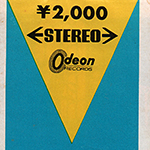 |
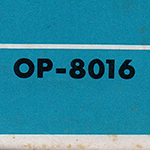 |
1st. pressing had a light blue / Yellow
OBI and priced ¥2,000 on obi strip. The word "STEREO" and
Odeon logo mark and catalog number "OP-8016" were printed on
the front. |
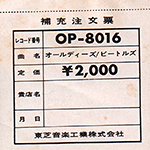 |
The obi remains intactwith
the order form on the back uncut. |
|
| FRONT AND BACK COVER CLOSE UP | |||||
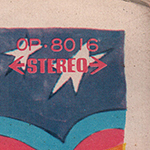 |
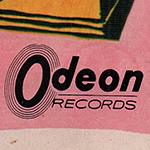 |
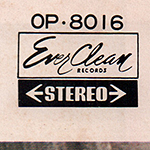 |
Odeon logo mark and catalog number "OP 8016"
were printed on both sides of the cover. "EverClean records" logo mark was printed at the upper right corner of the back cover. |
||
| BACK COVER CLOSE UP | |||||
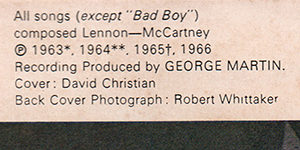 |
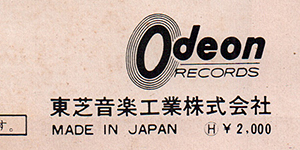 |
"Toshiba Musical
Industries Ltd." and "H-¥2,000" were printed at the bottom
of the back cover. |
|||
| LABEL CLOSE UP | |||||
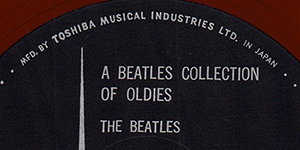 |
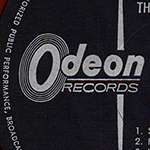 |
Toshiba
pressed a lot of their records on red, "Everclean" vinyl
from 1958 through 1974 (maybe). The Everclean vinyl
was designed to be less prone to collecting static
electricity and dust than the more common black vinyl. The
words "MFD. BY TOSHIBA MUSICAL INDUSTRIES LTD. IN JAPAN" was
printed at the perimeter. |
|||
| LABEL CLOSE UP | |||||
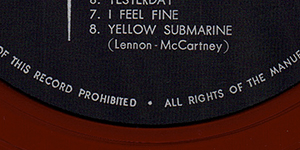 |
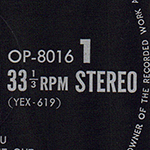 |
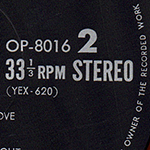 |
The words "LONG PLAYING"
was erased at the bottom of the label. Catalog number and matrix number were printed at the right side of the center hole. |
||
|
OTHER ITEM
|
|||||
| - |
|||||
| RECORD LABEL | Odeon Label Type-2 (without the words "LONG
PLAYING") |
||||
| MIX | STEREO |
||||
| MATRIX No. | SIDE 1 | YEX-619
1S 45 |
|||
| SIDE 2 | YEX-620 1S
46 |
||||
| PRESS MARK | F8 |
||||
| VINYL COLOR | RED |
||||
| RECORD COMPANY'S NAME | SLEEVE | Toshiba
Ongaku kogyo Kabusikigaisha |
|||
| LABEL | MFD. BY
TOSHIBA MUSICAL INDUSTRIES LTD. IN JAPAN |
||||
| SYMBOL/PRICE | H - ¥2,000 |
||||
| LYRIC SHEET STYLE | Bifold Type |
||||
| COVER FORM | Single type. Hard cover. |
||||
| INNER SLEEVE |
The original colour "advert" inner bag
Type-6-1 |
||||
| OBI |
Light blue / Yellow so called "Sankaku"
(triangle) or "V-shape" OBI |
||||
| COVER DESIGN/ PHOTO/ NOTES | Cover: David Christian Back Cover Photo: Robert Whittaker Liner Notes: Ichio Fukuda |
||||
|
COMMENTS
|
Black Odeon label with
silver print. The words "LONG PLAYING" was erased at the bottom of the label. Toshiba released the first Japanese record featuring the Beatles. When this record was released, Toshiba's official name was "Toshiba Musical Industries Ltd." and they used the Odeon label for this and subsequent Beatles releases. The front cover is similar to its U.K. counterpart, but the back cover photo is reversed (Japanese edition is correct). These copies mistitled the album title "A collection..." as "A Beatles collection..." on the spine of the cover and the label. Red vinyl: Besides good sound and quality printing, Japanese records also offered some other things of interest to the collector. One of the primary manufacturing companies in Japan, Toshiba, pressed a lot of their records on red, “Everclean” vinyl from 1958 through 1974 (maybe). While not pressed as collectors’ items, these red vinyl pressings are more sought out by collectors than their black vinyl counterparts. The Everclean vinyl was designed to be less prone to collecting static electricity and dust than the more common black vinyl. The obi: A. K. A."V-shape" Obi 1st. pressing had a light blue / yellow so called "Sankaku"(triangle) or "V-shape" OBI and priced ¥2,000 on rear sleeve and obi strip. While most Japanese records feature local music, a lot of music fans there like foreign music, as well. The language barrier in Japan presented a problem – should foreign album covers be changed for Japanese albums? The solution was the obi, which means “belt” or “sash”. The obi is a strip of paper, usually about two inches wide, that wraps vertically around the album cover, containing information about the artist and album in Japanese. As these strips of paper were fragile and easily torn, they are often missing, especially since consumers in the 1950s and 1960s attached little significance to them. Finding Japanese records made prior to 1970 that still have the obi intact can be quite difficult, and for some albums, nearly impossible. The inclusion of the obi can dramatically affect the price of some Japanese records, sometimes increasing the price by a factor of ten. This stereo versions of "She Loves You" have been created from the mono versions, because original master tapes are lost. |
||||
| TITLE | A BEATLES
COLLECTION OF OLDIES |
||||
| CATALOG NUMBER | AP-8016 |
||||
| RELEASE DATE | May1969? / Second Press |
||||
| TRACK LISTING | SIDE 1 | SIDE 2 | |||
| She Loves You (simulated stereo) |
Can't Buy Me Love |
||||
| From Me To You |
Bad Boy |
||||
| We Can Work It Out |
Day Tripper |
||||
| Help! |
A Hard Day's Night |
||||
| Michelle |
Ticket To Ride |
||||
| Yesterday |
Paperback Writer |
||||
| I Feel Fine |
Eleanor Rigby |
||||
| Yellow Submarine |
I Want To Hold Your Hand |
||||
| FRONT --> Click! | BACK --> Click! | SIDE 1 --> Click! | SIDE 2 --> Click! | DISK | |
 |
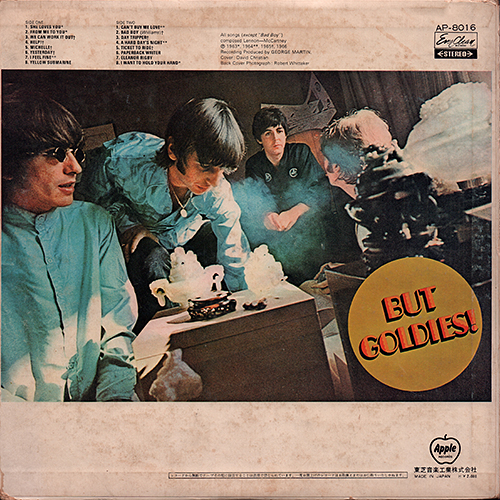 |
 |
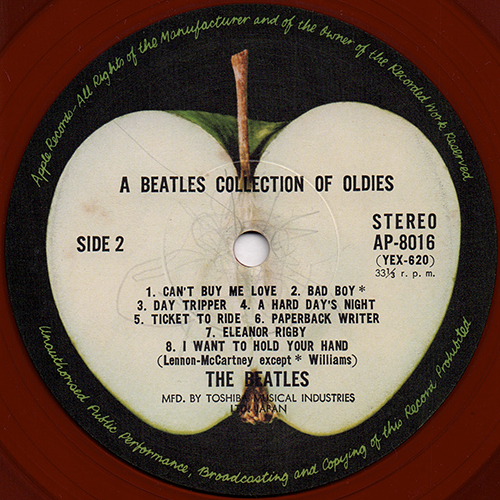 |
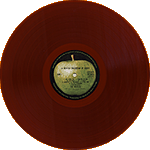 |
|
| INNER SLEEVE | LYRIC SHEET (Bifold Type) | ||||
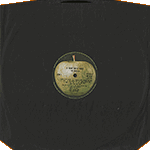 |
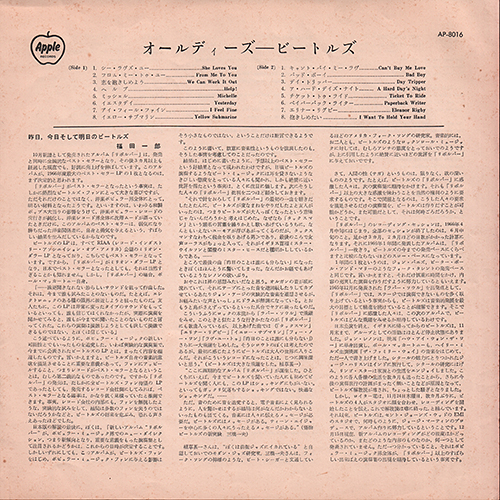 |
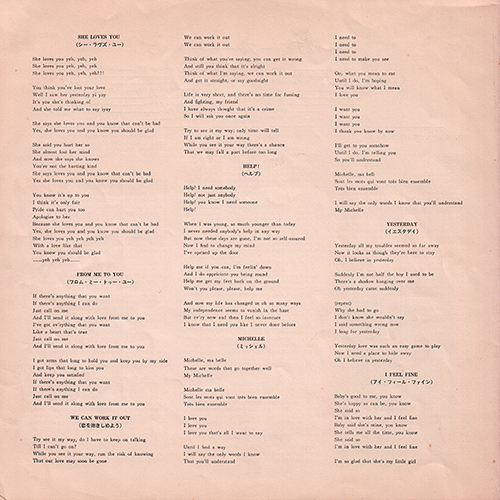 |
 |
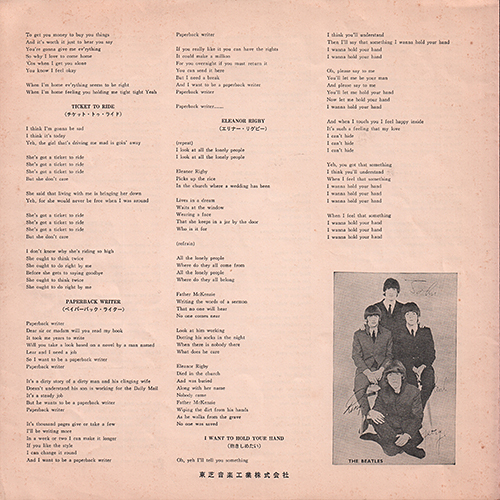 |
|
| LYRIC SHEET CLOSE
UP |
|||||
 |
 |
 |
|||
| Catalog number "AP 8016" was printed. |
Liner notes: Ichiro Fukuda. |
"Toshiba Musical Industries Ltd." was printed on the lyric sheet. | |||
| Light Blue / Yellow OBI CLOSE UP (Sorry, I
don't have it) |
|||||
| FRONT | BACK | ||||
| 2nd. pressing had a light
blue / Yellow OBI and priced ¥2,000 on obi strip. The word
"STEREO" and Apple logo mark and catalog number "AP-8016"
were printed on the front. |
With
the order form on the back. |
||||
| FRONT AND BACK COVER CLOSE UP | |||||
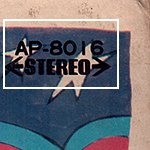 |
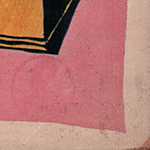 |
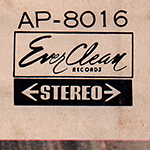 |
Catalog number "AP 8016" and the word "STEREO"
were printed in black
at the upper right corner of the front cover. "EverClean records" logo mark was printed at the upper right corner of the back cover. |
||
| BACK COVER CLOSE UP | |||||
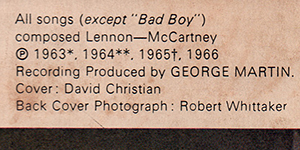 |
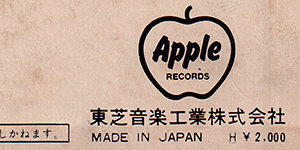 |
"Toshiba Musical
Industries Ltd." and "H-¥2,000" were printed at the bottom
of the back cover. |
|||
| LABEL CLOSE UP | |||||
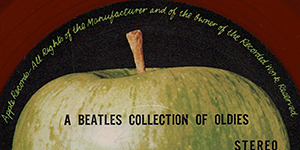 |
Toshiba pressed a lot of their records on red,
"Everclean" vinyl from 1958 through 1974 (maybe). The
Everclean vinyl was designed to be less prone to collecting
static electricity and dust than the more common black
vinyl. In 1969, Toshiba had to reissue on the Apple label all the records previously issued on the Odeon label. The phrase "Apple Records - All Rights of the Manufacturer and of the Owner of the Recorded work Reserved." was printed at the perimeter. |
||||
| LABEL CLOSE UP | |||||
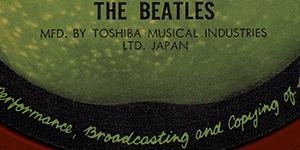 |
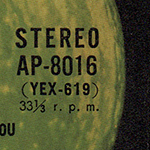 |
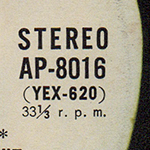 |
The words "MFD. BY TOSHIBA
MUSICAL INDUSTRIES LTD. JAPAN" was printed at the bottom on
the label. Catalog number "AP-8016" and matrix number were
printed at the right side of the center hole. |
||
|
OTHER ITEM
|
|||||
| - |
|||||
| RECORD LABEL | Dark Green Apple label Type-1 |
||||
| MIX | STEREO |
||||
| MATRIX No. | SIDE 1 | YEX-619
1S 53 |
|||
| SIDE 2 | YEX-620 1S
46 |
||||
| PRESS MARK | 8M
-> 9A -> 9E |
||||
| VINYL COLOR | RED |
||||
| RECORD COMPANY'S NAME | SLEEVE | Toshiba
Ongaku kogyo Kabusikigaisha |
|||
| LABEL | MFD. BY
TOSHIBA MUSICAL INDUSTRIES LTD. JAPAN |
||||
| SYMBOL/PRICE | H - ¥2,000 |
||||
| LYRIC SHEET STYLE | Bifold Type |
||||
| COVER FORM | Single type. Hard cover. |
||||
| INNER SLEEVE |
Apple custom black sleeve |
||||
| OBI |
Apple Light blue / Yellow so called
"Sankaku" (triangle) or "V-shape" OBI |
||||
| COVER DESIGN/ PHOTO/ NOTES | Cover: David Christian Back Cover Photo: Robert Whittaker Liner Notes: Ichio Fukuda |
||||
|
COMMENTS
|
Dark green Apple label
Type-1with black print. In late (September?)1969, Toshiba had to reissue on the Apple label all the records previously issued on the Odeon label. And in the Apple label, there are two subtypes, TOSHIBA MUSIC and TOSHIBA EMI. Further more, the early copies of the APPLE-TOSHIBA MUSIC type have dark Apple on its label, though the late copies have light one. The front cover is similar to its U.K. counterpart, but the back cover photo is reversed (Japanese edition is correct). These copies mistitled the album title "A collection..." as "A Beatles collection..." on the spine of the cover and the label. Red vinyl: Besides good sound and quality printing, Japanese records also offered some other things of interest to the collector. One of the primary manufacturing companies in Japan, Toshiba, pressed a lot of their records on red, “Everclean” vinyl from 1958 through 1974 (maybe). While not pressed as collectors’ items, these red vinyl pressings are more sought out by collectors than their black vinyl counterparts. The Everclean vinyl was designed to be less prone to collecting static electricity and dust than the more common black vinyl. The obi: A. K. A."V-shape" Obi 2nd. pressing had a light blue / yellow so called "Sankaku"(triangle) or "V-shape" OBI with Apple logo and priced ¥2,000 on rear sleeve and obi strip. While most Japanese records feature local music, a lot of music fans there like foreign music, as well. The language barrier in Japan presented a problem – should foreign album covers be changed for Japanese albums? The solution was the obi, which means “belt” or “sash”. The obi is a strip of paper, usually about two inches wide, that wraps vertically around the album cover, containing information about the artist and album in Japanese. As these strips of paper were fragile and easily torn, they are often missing, especially since consumers in the 1950s and 1960s attached little significance to them. Finding Japanese records made prior to 1970 that still have the obi intact can be quite difficult, and for some albums, nearly impossible. The inclusion of the obi can dramatically affect the price of some Japanese records, sometimes increasing the price by a factor of ten. This stereo versions of "She Loves You" have been created from the mono versions, because original master tapes are lost. |
||||
| TITLE | A BEATLES
COLLECTION OF OLDIES |
||||
| CATALOG NUMBER | AP-8016 |
||||
| RELEASE DATE | November1972? / Third Press
(CBS SONY Contract Press) |
||||
| TRACK LISTING | SIDE 1 | SIDE 2 | |||
| She Loves You (simulated stereo) |
Can't Buy Me Love |
||||
| From Me To You |
Bad Boy |
||||
| We Can Work It Out |
Day Tripper |
||||
| Help! |
A Hard Day's Night |
||||
| Michelle |
Ticket To Ride |
||||
| Yesterday |
Paperback Writer |
||||
| I Feel Fine |
Eleanor Rigby |
||||
| Yellow Submarine |
I Want To Hold Your Hand |
||||
| FRONT --> Click! | BACK --> Click! | SIDE 1 --> Click! | SIDE 2 --> Click! | DISK --> Click! | |
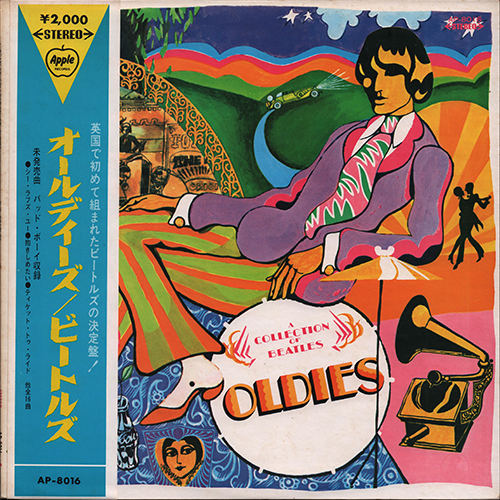 |
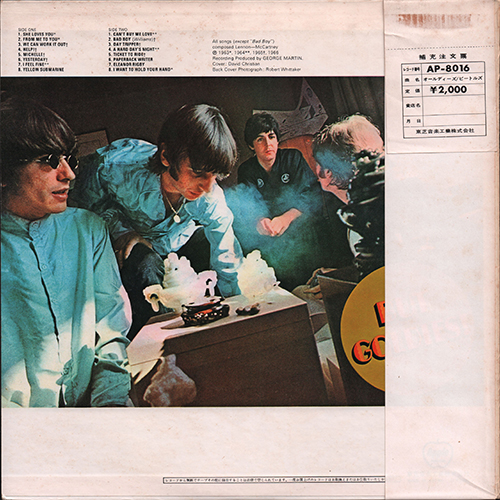 |
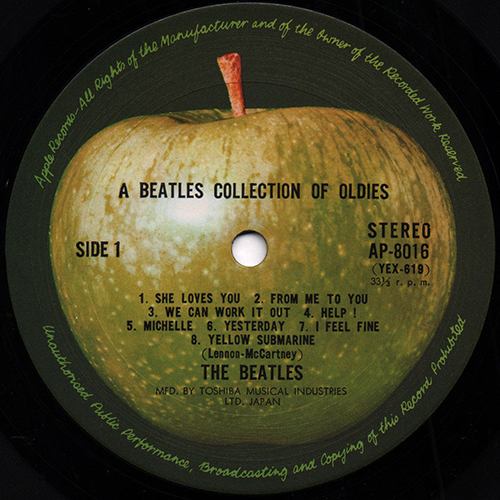 |
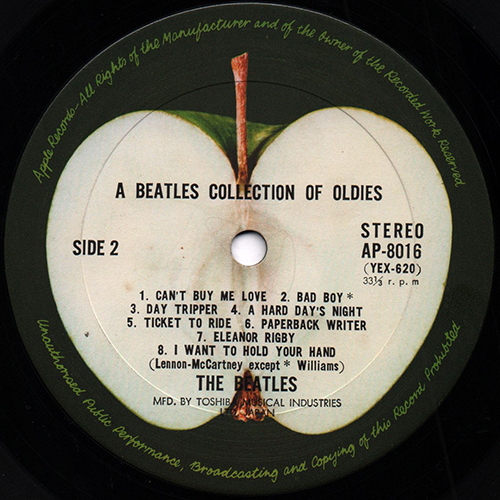 |
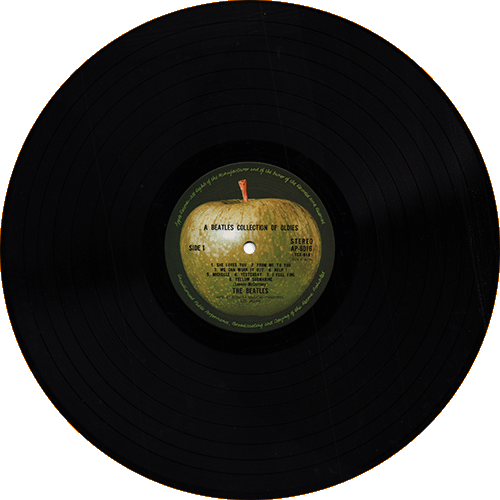 |
|
| INNER SLEEVE |
LYRIC SHEET (Bifold Type) | ||||
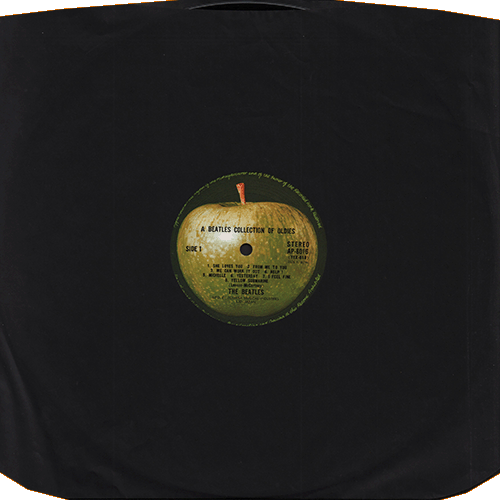 |
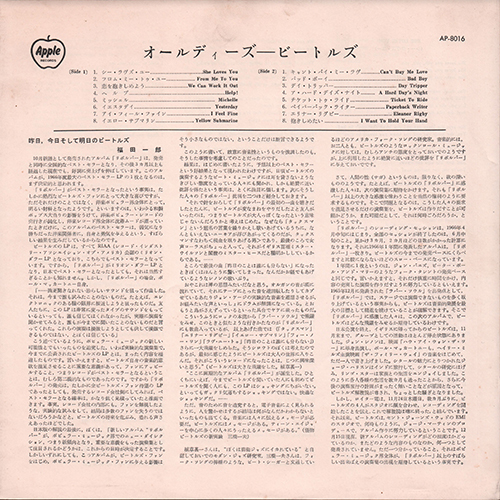 |
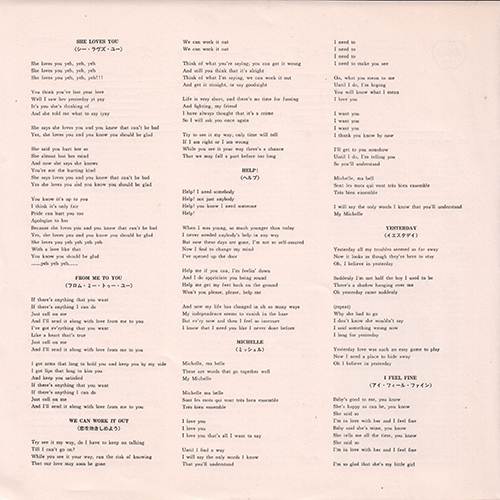 |
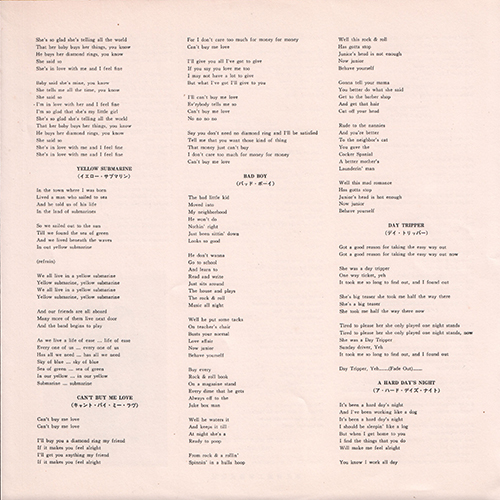 |
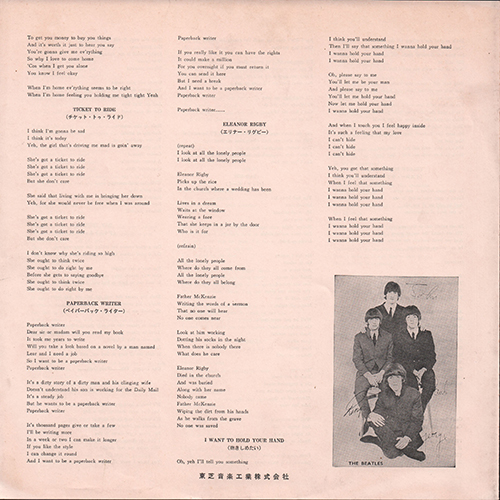 |
|
| LYRIC SHEET CLOSE
UP |
|||||
 |
 |
 |
|||
| Catalog number "AP 8016" was printed. |
Liner notes: Ichiro Fukuda. |
"Toshiba Musical Industries Ltd." was printed on the lyric sheet. | |||
| Apple Light Blue / Yellow OBI CLOSE UP |
|||||
| FRONT --> Click! | BACK --> Click! | ||||
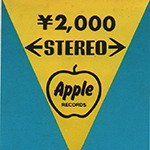 |
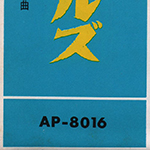 |
These pressing had a light blue / Yellow OBI. Priced ¥2,000 on obi strip. The word "STEREO" and Apple logo mark and catalog number "AP-8016" were printed on the front. | 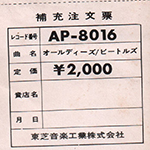 |
The obi remains intactwith the order form on the back uncut. | |
| FRONT AND BACK COVER CLOSE UP | |||||
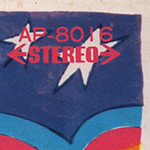 |
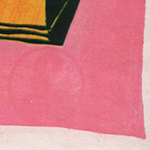 |
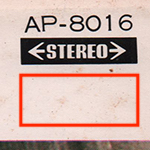 |
Catalog number "AP 8016" and the word "STEREO"
were printed in pink
at the upper right corner of the front cover. "EverClean records" logo mark was removed at the upper right corner of the back cover. |
||
| BACK COVER CLOSE UP | |||||
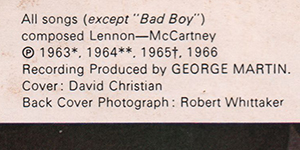 |
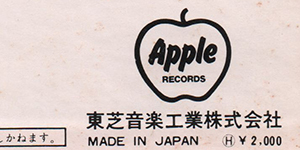 |
"Toshiba Musical
Industries Ltd." and "H-¥2,000" were printed at the bottom
of the back cover. |
|||
| LABEL CLOSE UP | |||||
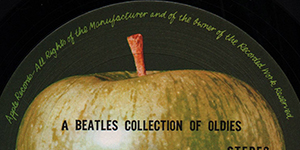 |
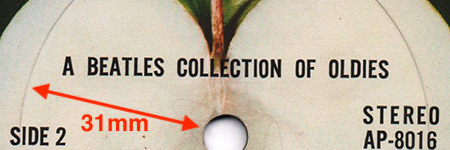 |
||||
| In 1969, Toshiba had to reissue on the Apple label all the records previously issued on the Odeon label. The phrase "Apple Records - All Rights of the Manufacturer and of the Owner of the Recorded work Reserved." was printed at the perimeter. | Sometimes
Toshiba had problems to press enough records to keep up with
the demand. To increase production they turned to other
companies (Gramophone, Sony etc.) to press up some copies of
a particular release. CBS Sony contract press: There is a ridge approximately 31mm out from the centre hole. |
||||
| LABEL CLOSE UP | |||||
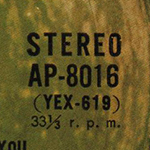 |
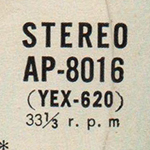 |
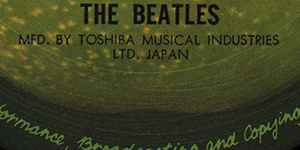 |
The words "MFD. BY TOSHIBA MUSICAL INDUSTRIES LTD. JAPAN" was printed at the bottom on the label. | ||
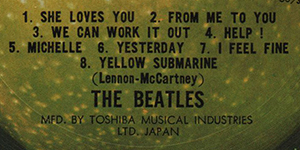 |
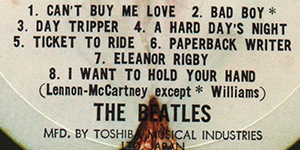 |
Dark green apple label. Slender font. Catalog number "AP-8016" and matrix number were printed at the right side of the center hole. |
|||
|
OTHER ITEM
|
|||||
| - |
|||||
| RECORD LABEL | Dark Green Apple label Type-1 |
||||
| MIX | STEREO |
||||
| MATRIX No. | SIDE 1 | YEX-619
1S 5 |
|||
| SIDE 2 | YEX-620 1S
2 |
||||
| PRESS MARK | F
S 4 |
||||
| VINYL COLOR | BLACK |
||||
| RECORD COMPANY'S NAME | SLEEVE | Toshiba
Ongaku
kogyo Kabusikigaisha |
|||
| LABEL | MFD. BY
TOSHIBA MUSICAL INDUSTRIES LTD. JAPAN |
||||
| SYMBOL/PRICE | H - ¥2,000 |
||||
| LYRIC SHEET STYLE | Bifold Type |
||||
| COVER FORM | Single type. Hard cover. |
||||
| INNER SLEEVE |
Apple custom black sleeve |
||||
| OBI |
Apple Light blue / Yellow so called
"Sankaku" (triangle) or "V-shape" OBI |
||||
| COVER DESIGN/ PHOTO/ NOTES | Cover: David Christian Back Cover Photo: Robert Whittaker Liner Notes: Ichio Fukuda |
||||
|
COMMENTS
|
Dark green Apple label
Type-1with black print. In Novemver 1968, that was the date when Apple Corp Ltd. of England and Toshiba came to an agreement on the manufacturing and distribution of the Beatles' records in Japan. As part of that agreement, Toshiba had to reissue on the Apple label all the records previously issued on the Odeon label. The sleeves also had to be altered to desplay the Apple logo. Futher still, all the Odeon catalog number prefixes were changed to ones with Apple prefixes. In most cases, only the prefixes were changed and the catalog numbers were left intanct. Odeon singles, EPs, and LPs with the OR or OP prefixes were changed to Apple singles, EPs, and LPs with the AR or AP prefixes, respectively. But Toshiba did not instantly implement all these changes and did not immediately withdraw all Odeon label records. In fact, the phasing out of the Odeon label products and the phasing in of the Apple label was a lengthy process taking several months at least. The very first record in Japan issued under the Toshiba/Apple contract and bearing the Apple label was "The Beatles double LP (the White Album)", released on 21th. January 1969. And unlike elsewhere in the world, the first single in Japan to bear the Apple label was not "Hey Jude / Revolution" but rather "Ob- La-Di, Ob-La-Da / While My Guitar Gently Weeps", released on 10th. March, 1969. And in the Apple label, there are two subtypes, TOSHIBA MUSIC and TOSHIBA EMI. Further more, the early copies of the APPLE-TOSHIBA MUSIC type have dark Apple on its label, though the late copies have light one. The front cover is similar to its U.K. counterpart, but the back cover photo is reversed (Japanese edition is correct). These copies mistitled the album title "A collection..." as "A Beatles collection..." on the spine of the cover and the label. AP-8016 contract pressings: CBS SONY Contract Press PM=none There is a ridge approximately 31mm out from the centre hole (The diameter of the ridge is 69mm). Red vinyl: Besides good sound and quality printing, Japanese records also offered some other things of interest to the collector. One of the primary manufacturing companies in Japan, Toshiba, pressed a lot of their records on red, “Everclean” vinyl from 1958 through 1974 (maybe). While not pressed as collectors’ items, these red vinyl pressings are more sought out by collectors than their black vinyl counterparts. The Everclean vinyl was designed to be less prone to collecting static electricity and dust than the more common black vinyl. The obi: A. K. A."V-shape" Obi 2nd. and 3rd. pressing had a light blue / yellow so called "Sankaku"(triangle) or "V-shape" OBI with Apple logo and priced ¥2,000 on rear sleeve and obi strip. While most Japanese records feature local music, a lot of music fans there like foreign music, as well. The language barrier in Japan presented a problem – should foreign album covers be changed for Japanese albums? The solution was the obi, which means “belt” or “sash”. The obi is a strip of paper, usually about two inches wide, that wraps vertically around the album cover, containing information about the artist and album in Japanese. As these strips of paper were fragile and easily torn, they are often missing, especially since consumers in the 1950s and 1960s attached little significance to them. Finding Japanese records made prior to 1970 that still have the obi intact can be quite difficult, and for some albums, nearly impossible. The inclusion of the obi can dramatically affect the price of some Japanese records, sometimes increasing the price by a factor of ten. This stereo versions of "She Loves You" have been created from the mono versions, because original master tapes are lost. |
||||
| TITLE | A BEATLES
COLLECTION OF OLDIES |
||||
| CATALOG NUMBER | AP-8016 |
||||
| RELEASE DATE | November1972? / Third Press |
||||
| TRACK LISTING | SIDE 1 | SIDE 2 | |||
| She Loves You (simulated stereo) |
Can't Buy Me Love |
||||
| From Me To You |
Bad Boy |
||||
| We Can Work It Out |
Day Tripper |
||||
| Help! |
A Hard Day's Night |
||||
| Michelle |
Ticket To Ride |
||||
| Yesterday |
Paperback Writer |
||||
| I Feel Fine |
Eleanor Rigby |
||||
| Yellow Submarine |
I Want To Hold Your Hand |
||||
| FRONT --> Click! | BACK --> Click! | SIDE 1 --> Click! | SIDE 2 --> Click! | DISK | |
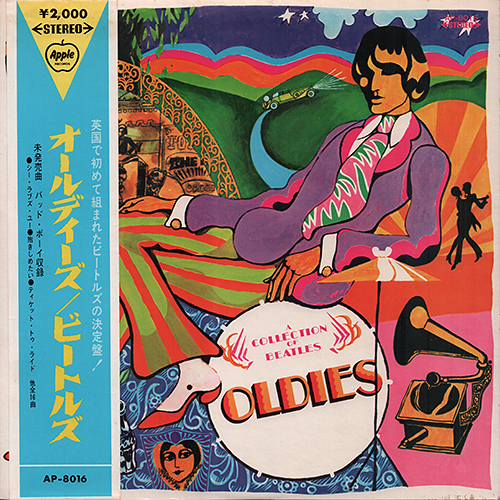 |
 |
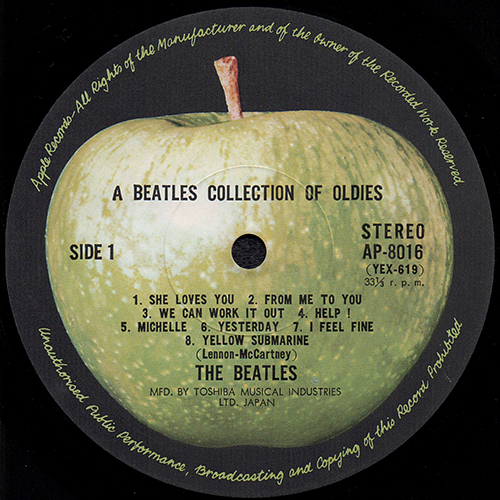 |
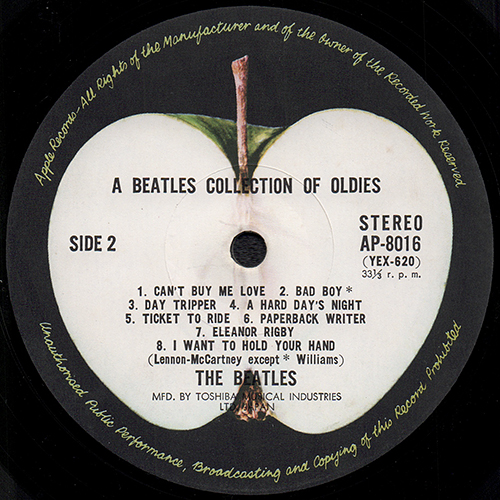 |
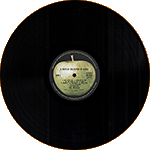 |
|
| INNER SLEEVE | LYRIC SHEET (Bifold Type) | ||||
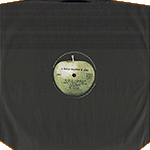 |
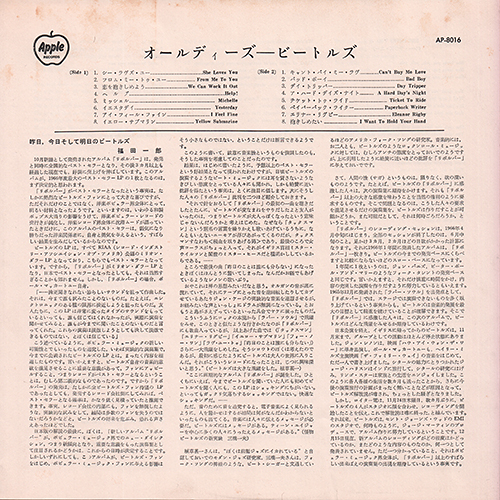 |
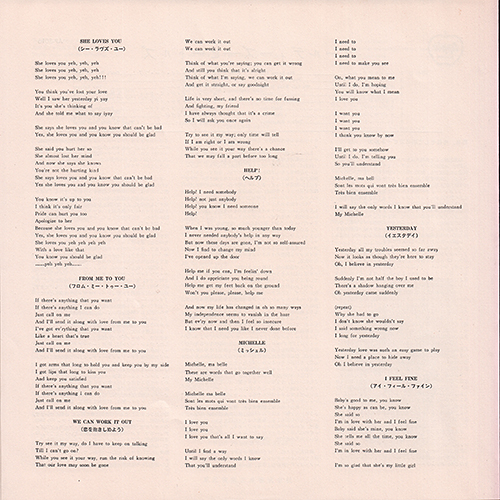 |
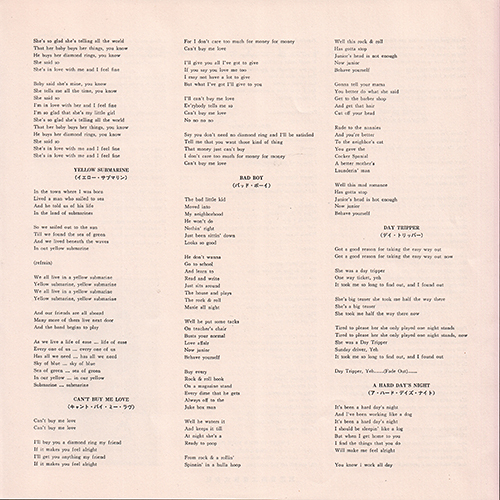 |
 |
|
| LYRIC SHEET CLOSE
UP |
|||||
 |
 |
 |
|||
| Catalog number "AP 8016" was printed. |
Liner notes: Ichiro Fukuda. |
"Toshiba Musical Industries Ltd." was printed on the lyric sheet. | |||
| Apple Light Blue / Yellow OBI CLOSE UP |
|||||
| FRONT --> Click! | BACK --> Click! | ||||
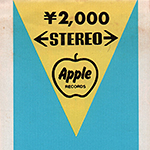 |
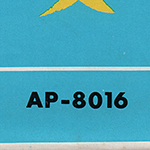 |
These pressing had a light blue / Yellow OBI. Priced ¥2,000 on obi strip. The word "STEREO" and Apple logo mark and catalog number "AP-8016" were printed on the front. | 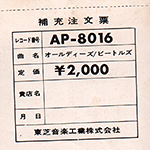 |
The obi remains intactwith the order form on the back uncut. | |
| FRONT AND BACK COVER CLOSE UP | |||||
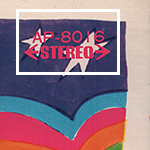 |
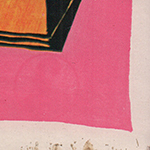 |
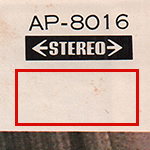 |
Catalog number "AP 8016" and the word "STEREO"
were printed in pink
at the upper right corner of the front cover. "EverClean records" logo mark was removed at the upper right corner of the back cover. |
||
| BACK COVER CLOSE UP | |||||
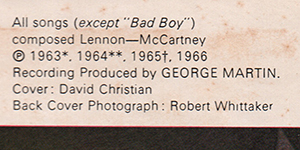 |
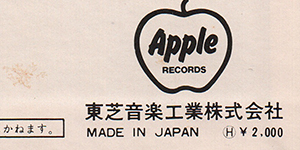 |
"Toshiba Musical
Industries Ltd." and "H-¥2,000" were printed at the bottom
of the back cover. |
|||
| LABEL CLOSE UP | |||||
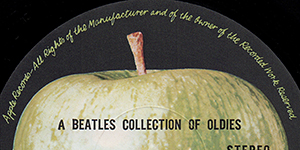 |
In 1969, Toshiba had to reissue on the Apple
label all the records previously issued on the Odeon label. The phrase "Apple Records - All Rights of the Manufacturer and of the Owner of the Recorded work Reserved." was printed at the perimeter. |
||||
| LABEL CLOSE UP | |||||
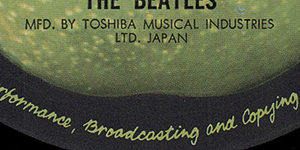 |
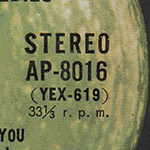 |
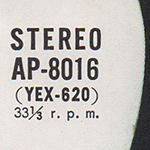 |
The words "MFD. BY TOSHIBA
MUSICAL INDUSTRIES LTD. JAPAN" was printed at the bottom on
the label. Catalog number "AP-8016" and matrix number were
printed at the right side of the center hole. |
||
|
OTHER ITEM
|
|||||
| - |
|||||
| RECORD LABEL | Light Green Apple label Type-2-1 |
||||
| MIX | STEREO |
||||
| MATRIX No. | SIDE 1 | YEX-619
3S 32 |
|||
| SIDE 2 | YEX-620 2S
59 |
||||
| PRESS MARK | 2L |
||||
| VINYL COLOR | BLACK |
||||
| RECORD COMPANY'S NAME | SLEEVE | Toshiba
Ongaku
kogyo Kabusikigaisha |
|||
| LABEL | MFD. BY
TOSHIBA MUSICAL INDUSTRIES LTD. JAPAN |
||||
| SYMBOL/PRICE | H - ¥2,000 |
||||
| LYRIC SHEET STYLE | Bifold Type |
||||
| COVER FORM | Single type. Hard cover. |
||||
| INNER SLEEVE |
Apple custom black sleeve |
||||
| OBI |
Apple Light blue / Yellow so called
"Sankaku" (triangle) or "V-shape" OBI |
||||
| COVER DESIGN/ PHOTO/ NOTES | Cover: David Christian Back Cover Photo: Robert Whittaker Liner Notes: Ichio Fukuda |
||||
|
COMMENTS
|
Light green Apple
label Type-2-1with black print. In late (September?)1969, Toshiba had to reissue on the Apple label all the records previously issued on the Odeon label. And in the Apple label, there are two subtypes, TOSHIBA MUSIC and TOSHIBA EMI. Further more, the early copies of the APPLE-TOSHIBA MUSIC type have dark Apple on its label, though the late copies have light one. The front cover is similar to its U.K. counterpart, but the back cover photo is reversed (Japanese edition is correct). These copies mistitled the album title "A collection..." as "A Beatles collection..." on the spine of the cover and the label. Red vinyl: Besides good sound and quality printing, Japanese records also offered some other things of interest to the collector. One of the primary manufacturing companies in Japan, Toshiba, pressed a lot of their records on red, “Everclean” vinyl from 1958 through 1974 (maybe). While not pressed as collectors’ items, these red vinyl pressings are more sought out by collectors than their black vinyl counterparts. The Everclean vinyl was designed to be less prone to collecting static electricity and dust than the more common black vinyl. The obi: A. K. A."V-shape" Obi 2nd. and 3rd. pressing had a light blue / yellow so called "Sankaku"(triangle) or "V-shape" OBI with Apple logo and priced ¥2,000 on rear sleeve and obi strip. While most Japanese records feature local music, a lot of music fans there like foreign music, as well. The language barrier in Japan presented a problem – should foreign album covers be changed for Japanese albums? The solution was the obi, which means “belt” or “sash”. The obi is a strip of paper, usually about two inches wide, that wraps vertically around the album cover, containing information about the artist and album in Japanese. As these strips of paper were fragile and easily torn, they are often missing, especially since consumers in the 1950s and 1960s attached little significance to them. Finding Japanese records made prior to 1970 that still have the obi intact can be quite difficult, and for some albums, nearly impossible. The inclusion of the obi can dramatically affect the price of some Japanese records, sometimes increasing the price by a factor of ten. This stereo versions of "She Loves You" have been created from the mono versions, because original master tapes are lost. |
||||
| TITLE | A BEATLES
COLLECTION OF OLDIES |
||||
| CATALOG NUMBER | AP-8016 |
||||
| RELEASE DATE | October1974? / 4th. Press |
||||
| TRACK LISTING | SIDE 1 | SIDE 2 | |||
| She Loves You (simulated stereo) |
Can't Buy Me Love |
||||
| From Me To You |
Bad Boy |
||||
| We Can Work It Out |
Day Tripper |
||||
| Help! |
A Hard Day's Night |
||||
| Michelle |
Ticket To Ride |
||||
| Yesterday |
Paperback Writer |
||||
| I Feel Fine |
Eleanor Rigby |
||||
| Yellow Submarine |
I Want To Hold Your Hand |
||||
| FRONT --> Click! | BACK --> Click! | SIDE 1 --> Click! | SIDE 2 --> Click! | DISK | |
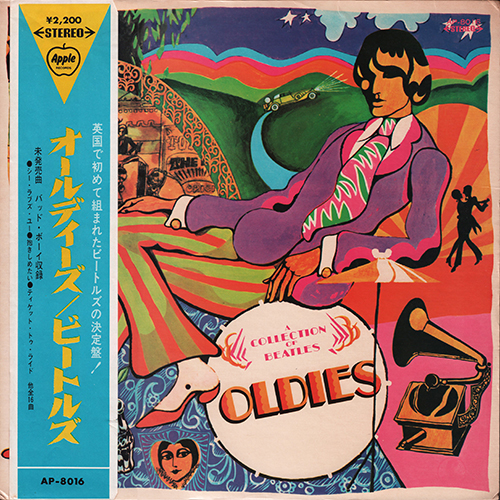 |
 |
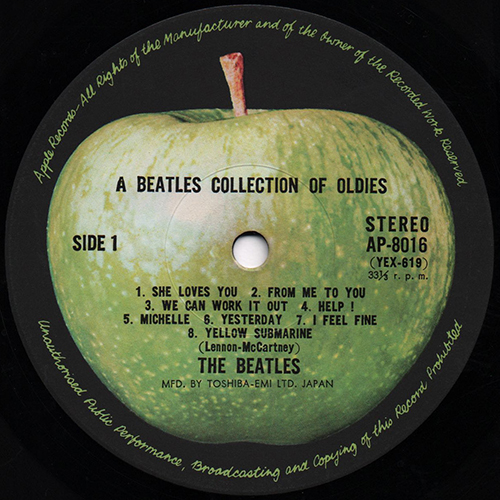 |
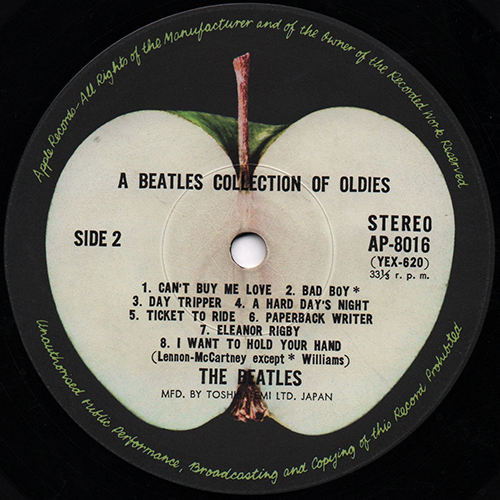 |
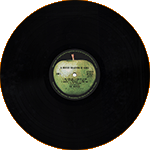 |
|
| INNER SLEEVE | LYRIC SHEET (Bifold Type) | ||||
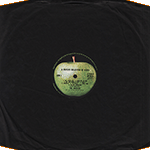 |
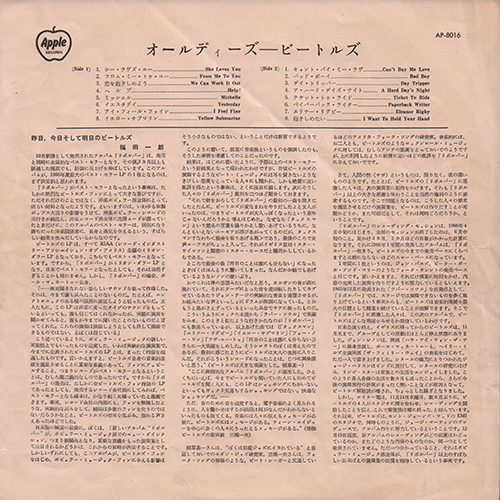 |
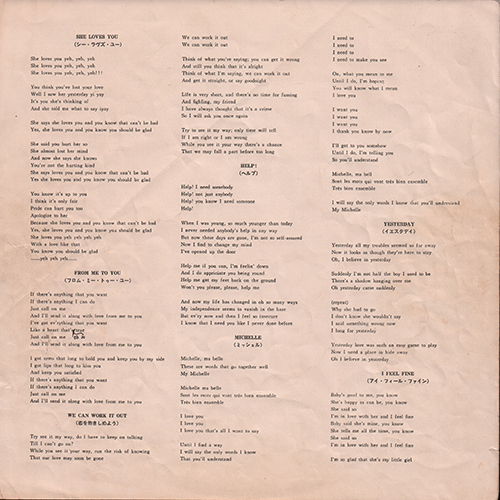 |
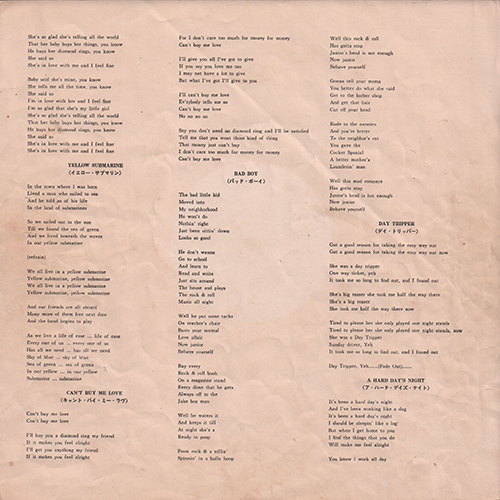 |
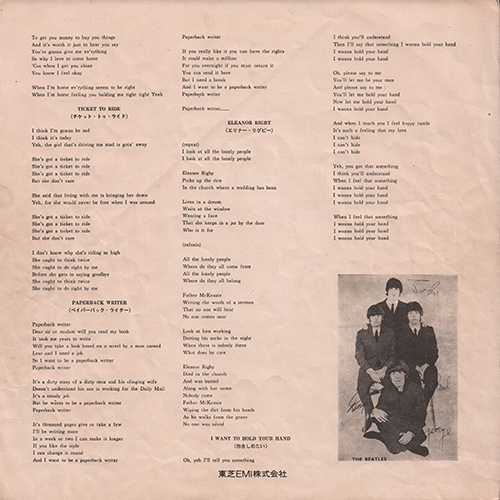 |
|
| LYRIC SHEET CLOSE
UP |
|||||
 |
 |
 |
|||
| Catalog number "AP 8016" was printed. |
Liner notes: Ichiro Fukuda. |
"Toshiba EMI Ltd." was printed on the lyric sheet. | |||
| Apple Light Blue / Yellow OBI CLOSE UP |
|||||
| FRONT --> Click! | BACK --> Click! | ||||
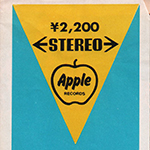 |
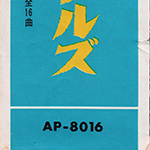 |
These pressing had a light blue / Yellow OBI. Priced ¥2,200 on obi strip. The word "STEREO" and Apple logo mark and catalog number "AP-8016" were printed on the front. | 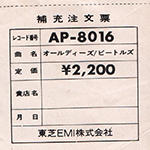 |
The obi remains intactwith
the order form on the back uncut. priced ¥2,200 on obi strip. The word "Toshiba EMI Ltd." was printed. |
|
| FRONT AND BACK COVER CLOSE UP | |||||
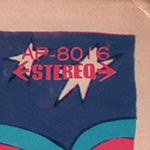 |
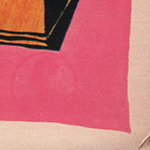 |
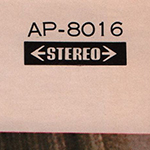 |
Catalog number "AP 8016" and the word "STEREO"
were printed in pink at the upper right corner of the front
cover. "EverClean records" logo mark was not printed at the upper right corner of the back cover. |
||
| BACK COVER CLOSE UP | |||||
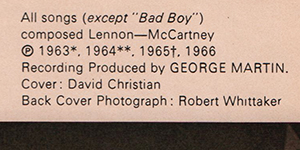 |
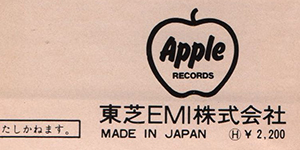 |
"Toshiba EMI Ltd." and "H-¥2,200" were printed at
the bottom of the back cover. |
|||
| LABEL CLOSE UP | |||||
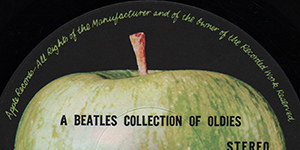 |
In 1969, Toshiba had to reissue on the Apple
label all the records previously issued on the Odeon label. The phrase "Apple Records - All Rights of the Manufacturer and of the Owner of the Recorded work Reserved." was printed at the perimeter. |
||||
| LABEL CLOSE UP | |||||
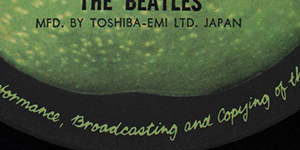 |
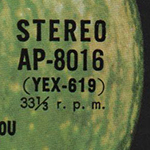 |
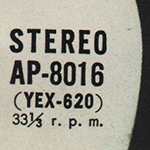 |
The words "MFD. BY TOSHIBA-EMI LTD. JAPAN"
was printed at the bottom on the label. Catalog number
"AP-8016" and matrix number were printed at the right side
of the center hole. |
||
| LABEL CLOSE UP | |||||
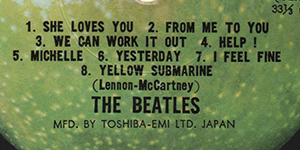 |
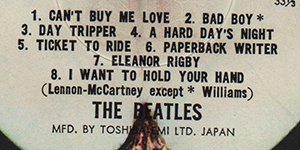 |
This stereo versions of "She Loves You"
have been created from the mono versions, because original
master tapes are lost. |
|||
|
OTHER ITEM
|
|||||
| - |
|||||
| RECORD LABEL | Light Green Apple label Type-2-2 |
||||
| MIX | STEREO |
||||
| MATRIX No. | SIDE 1 | YEX-619 3S2
40 |
|||
| SIDE 2 | YEX-620 2S
129 |
||||
| PRESS MARK | 4-9WXW |
||||
| VINYL COLOR | BLACK |
||||
| RECORD COMPANY'S NAME | SLEEVE | Toshiba
EMI Kabusikigaisha |
|||
| LABEL | MFD. BY
TOSHIBA MUSICAL -EMI. JAPAN |
||||
| SYMBOL/PRICE | H - ¥2,200 |
||||
| LYRIC SHEET STYLE | Bifold Type |
||||
| COVER FORM | Single type. Hard cover. |
||||
| INNER SLEEVE |
Apple custom black sleeve |
||||
| OBI |
Apple Light blue / Yellow so called
"Sankaku" (triangle) or "V-shape" OBI |
||||
| COVER DESIGN/ PHOTO/ NOTES | Cover: David Christian Back Cover Photo: Robert Whittaker Liner Notes: Ichio Fukuda |
||||
|
COMMENTS
|
Light green Apple
label Type-2-2 with black print. In late (September?)1969, Toshiba had to reissue on the Apple label all the records previously issued on the Odeon label. And in the Apple label, there are two subtypes, TOSHIBA MUSIC and TOSHIBA EMI. Further more, the early copies of the APPLE-TOSHIBA MUSIC type have dark Apple on its label, though the late copies have light one. * On 1st. October 1973, Toshiba Musical Industries was changed its name to Toshiba-EMI Ltd. The front cover is similar to its U.K. counterpart, but the back cover photo is reversed (Japanese edition is correct). These copies mistitled the album title "A collection..." as "A Beatles collection..." on the spine of the cover and the label. Red vinyl: Besides good sound and quality printing, Japanese records also offered some other things of interest to the collector. One of the primary manufacturing companies in Japan, Toshiba, pressed a lot of their records on red, “Everclean” vinyl from 1958 through 1974 (maybe). While not pressed as collectors’ items, these red vinyl pressings are more sought out by collectors than their black vinyl counterparts. The Everclean vinyl was designed to be less prone to collecting static electricity and dust than the more common black vinyl. The obi: A. K. A."V-shape" Obi 4th. pressing had a light blue / yellow so called "Sankaku"(triangle) or "V-shape" OBI with Apple logo and priced ¥2,200 on obi strip. The word "Toshiba EMI Ltd." was printed. The obi remains intactwith the order form on the back uncut. In 1973, the V-shaped Obi was changed to Forever Obi, so it was supposed to be sold as Forever Obi. However, even after the LP price rose to 2200 yen in December 1973, the V-shaped obi continued. Because there is a V-shaped obi with 2200 yen printed notation. The company name was changed to Toshiba EMI when the price increased. There is a V-shaped Obi with an order sheet printed with Toshiba EMI, so it is thought that it was manufactured immediately after the price revision. There is also a V-shaped Obi without an order sheet, and it can be seen that it was sold with a V-shaped Obi for a certain period of time. While most Japanese records feature local music, a lot of music fans there like foreign music, as well. The language barrier in Japan presented a problem – should foreign album covers be changed for Japanese albums? The solution was the obi, which means “belt” or “sash”. The obi is a strip of paper, usually about two inches wide, that wraps vertically around the album cover, containing information about the artist and album in Japanese. As these strips of paper were fragile and easily torn, they are often missing, especially since consumers in the 1950s and 1960s attached little significance to them. Finding Japanese records made prior to 1970 that still have the obi intact can be quite difficult, and for some albums, nearly impossible. The inclusion of the obi can dramatically affect the price of some Japanese records, sometimes increasing the price by a factor of ten. This stereo versions of "She Loves You" have been created from the mono versions, because original master tapes are lost. |
||||
| TITLE | A BEATLES
COLLECTION OF OLDIES |
||||
| CATALOG NUMBER | AP-8016 |
||||
| RELEASE DATE | October1974? / 5th. Press |
||||
| TRACK LISTING | SIDE 1 | SIDE 2 | |||
| She Loves You (simulated stereo) |
Can't Buy Me Love |
||||
| From Me To You |
Bad Boy |
||||
| We Can Work It Out |
Day Tripper |
||||
| Help! |
A Hard Day's Night |
||||
| Michelle |
Ticket To Ride |
||||
| Yesterday |
Paperback Writer |
||||
| I Feel Fine |
Eleanor Rigby |
||||
| Yellow Submarine |
I Want To Hold Your Hand |
||||
| FRONT --> Click! | BACK --> Click! | SIDE 1 --> Click! | SIDE 2 --> Click! | DISK | |
 |
 |
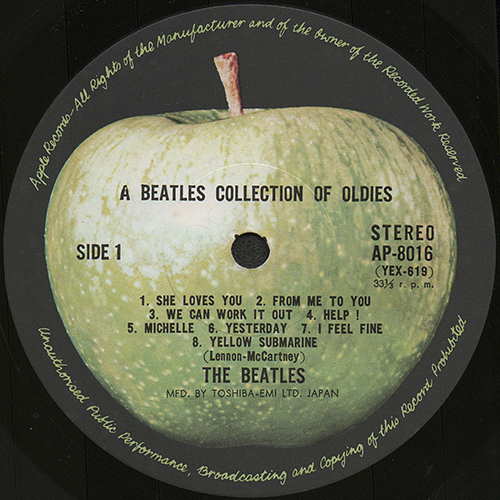 |
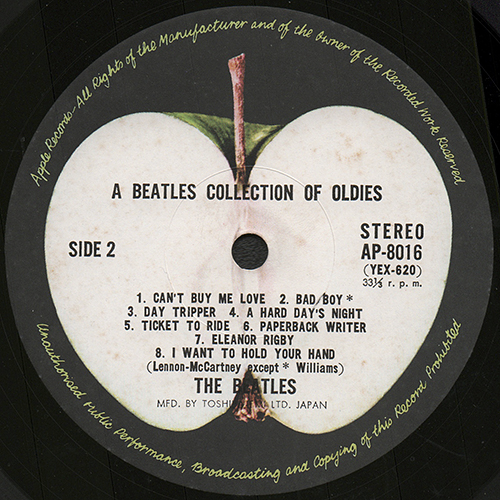 |
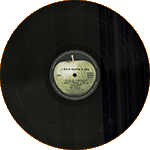 |
|
| INNER SLEEVE | LYRIC SHEET (Bifold Type) | ||||
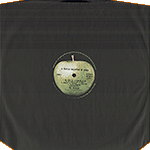 |
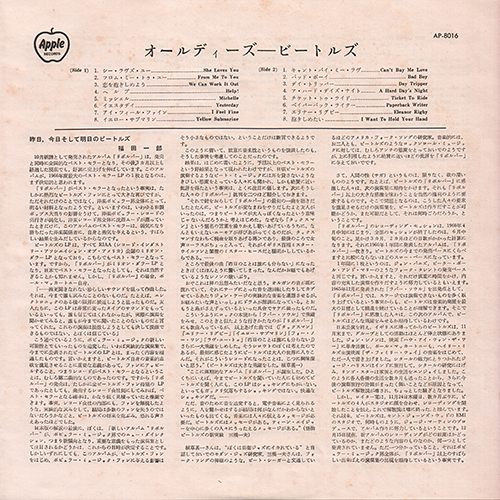 |
 |
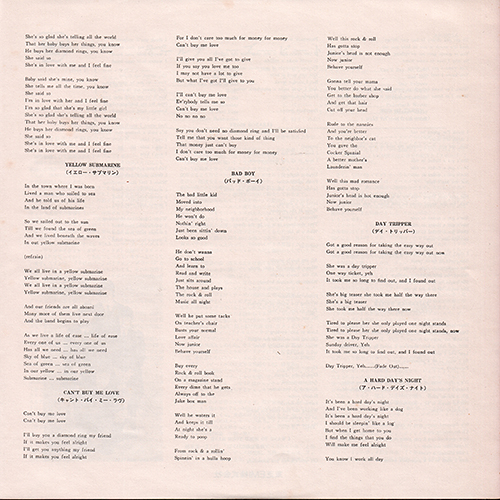 |
 |
|
| LYRIC SHEET CLOSE
UP |
|||||
 |
 |
 |
|||
| Catalog number "AP 8016" was printed. |
Liner notes: Ichiro Fukuda. |
"Toshiba EMI Ltd." was printed on the lyric sheet. | |||
| Apple Light Blue / Yellow OBI CLOSE UP |
|||||
| FRONT --> Click! | BACK --> Click! | ||||
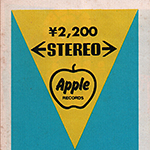 |
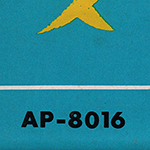 |
These pressing had a light blue / Yellow OBI. Priced ¥2,200 on obi strip. The word "STEREO" and Apple logo mark and catalog number "AP-8016" were printed on the front. | 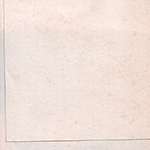 |
The order form was NOT printed on the back uncut. | |
| FRONT AND BACK COVER CLOSE UP | |||||
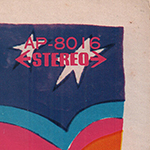 |
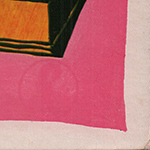 |
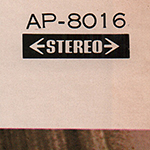 |
Catalog number "AP 8016" and the word "STEREO"
were printed in pink at the upper right corner of the front
cover. "EverClean records" logo mark was not printed at the upper right corner of the back cover. |
||
| BACK COVER CLOSE UP | |||||
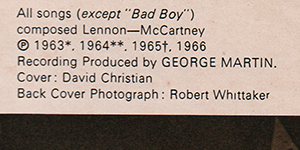 |
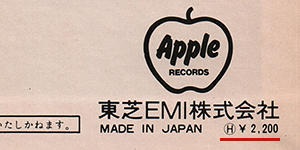 |
"Toshiba EMI Ltd." and "H-¥2,200" were printed at
the bottom of the back cover. |
|||
| LABEL CLOSE UP | |||||
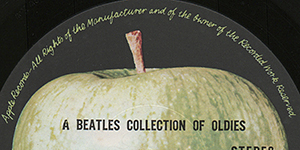 |
In 1969, Toshiba had to reissue on the Apple
label all the records previously issued on the Odeon label. The phrase "Apple Records - All Rights of the Manufacturer and of the Owner of the Recorded work Reserved." was printed at the perimeter. |
||||
| LABEL CLOSE UP | |||||
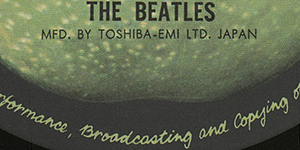 |
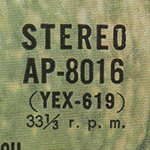 |
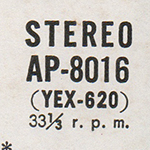 |
The words "MFD. BY TOSHIBA-EMI LTD. JAPAN"
was printed at the bottom on the label. Catalog number
"AP-8016" and matrix number were printed at the right side
of the center hole. |
||
|
OTHER ITEM
|
|||||
| - |
|||||
| RECORD LABEL | Light Green Apple label Type-2-2 |
||||
| MIX | STEREO |
||||
| MATRIX No. | SIDE 1 | YEX-619 3S2
40 |
|||
| SIDE 2 | YEX-620 2S
129 |
||||
| PRESS MARK | 4-9WXW |
||||
| VINYL COLOR | BLACK |
||||
| RECORD COMPANY'S NAME | SLEEVE | Toshiba
EMI
Kabusikigaisha |
|||
| LABEL | MFD. BY
TOSHIBA-EMI LTD. JAPAN |
||||
| SYMBOL/PRICE | H - ¥2,200 |
||||
| LYRIC SHEET STYLE | Bifold Type |
||||
| COVER FORM | Single type. Hard cover. |
||||
| INNER SLEEVE |
Apple custom black sleeve |
||||
| OBI |
Apple Light blue / Yellow so called
"Sankaku" (triangle) or "V-shape" OBI |
||||
| COVER DESIGN/ PHOTO/ NOTES | Cover: David Christian Back Cover Photo: Robert Whittaker Liner Notes: Ichio Fukuda |
||||
|
COMMENTS
|
Light green Apple
label Type-2-2 with black print. In late (September?)1969, Toshiba had to reissue on the Apple label all the records previously issued on the Odeon label. And in the Apple label, there are two subtypes, TOSHIBA MUSIC and TOSHIBA EMI. Further more, the early copies of the APPLE-TOSHIBA MUSIC type have dark Apple on its label, though the late copies have light one. * On 1st. October 1973, Toshiba Musical Industries was changed its name to Toshiba-EMI Ltd. The front cover is similar to its U.K. counterpart, but the back cover photo is reversed (Japanese edition is correct). These copies mistitled the album title "A collection..." as "A Beatles collection..." on the spine of the cover and the label. Red vinyl: Besides good sound and quality printing, Japanese records also offered some other things of interest to the collector. One of the primary manufacturing companies in Japan, Toshiba, pressed a lot of their records on red, “Everclean” vinyl from 1958 through 1974 (maybe). While not pressed as collectors’ items, these red vinyl pressings are more sought out by collectors than their black vinyl counterparts. The Everclean vinyl was designed to be less prone to collecting static electricity and dust than the more common black vinyl. The obi: A. K. A."V-shape" Obi 5th. pressing had a light blue / yellow so called "Sankaku"(triangle) or "V-shape" OBI with Apple logo and priced ¥2,200 on obi strip. On the rear side, the order form was NOT printed on the back uncut. In 1973, the V-shaped Obi was changed to Forever Obi, so it was supposed to be sold as Forever Obi. However, even after the LP price rose to 2200 yen in December 1973, the V-shaped obi continued. Because there is a V-shaped obi with 2200 yen printed notation. The company name was changed to Toshiba EMI when the price increased. There is a V-shaped Obi with an order sheet printed with Toshiba EMI, so it is thought that it was manufactured immediately after the price revision. There is also a V-shaped Obi without an order sheet, and it can be seen that it was sold with a V-shaped Obi for a certain period of time. While most Japanese records feature local music, a lot of music fans there like foreign music, as well. The language barrier in Japan presented a problem – should foreign album covers be changed for Japanese albums? The solution was the obi, which means “belt” or “sash”. The obi is a strip of paper, usually about two inches wide, that wraps vertically around the album cover, containing information about the artist and album in Japanese. As these strips of paper were fragile and easily torn, they are often missing, especially since consumers in the 1950s and 1960s attached little significance to them. Finding Japanese records made prior to 1970 that still have the obi intact can be quite difficult, and for some albums, nearly impossible. The inclusion of the obi can dramatically affect the price of some Japanese records, sometimes increasing the price by a factor of ten. This stereo versions of "She Loves You" have been created from the mono versions, because original master tapes are lost. |
||||
